Fireworks, called hanabi in Japanese, are a staple symbol of summer in Japan - and Japan goes all out for fireworks festivals! Make sure to try to catch at least one of these events in the summer (or sometimes in the off-seasons!) and know what to expect when you do attend one of these crowd-drawing extravaganzas.
First Posted: 2021/10/13
Updated: 2023/6/21
Table of Contents
- A Brief Intro to Hanabi and Hanabi Festivals
- 8+ Famous Fireworks Festivals in Japan
- What to Know When Attending a Fireworks Festival in Japan
A Brief Intro to Hanabi and Hanabi Festivals
Hanabi or fireworks are one of the top things that come to mind for many Japanese people when they think of summer. Why is that the case? Let’s take a brief look!
What does Hanabi Mean?

Hanabi - written 花火 in kanji characters - is the Japanese word for fireworks. 花 Hana means “flower” and 火 bi (hi) means “fire”.
The type of hanabi you see at hanabi festivals are uchiage hanabi (打ち上げ花火) - fireworks that are launched into the air (as opposed to temochi hanabi (手持ち花火), fireworks wands/sticks you can enjoy by holding them in your hands).
You may have heard the phrase uchiage hanabi because of the song 打上花火 (Uchiage Hanabi) by DAOKO and Yonezu Kenshi that was a megahit when released in 2017. This song is now a staple song we hear during the summer in Japan.
There are several other common words and phrases related to hanabi that you will hear over the summer.
-
Hanabi taikai (花火大会) - fireworks festivals; these can simply be fireworks shows, or sometimes they are fireworks competitions
-
Hanabi kyogi taikai (花火競技大会) - fireworks competition; while viewers can enjoy the fireworks as usual, there are stakes involved as hanabishi compete to out-do each other
-
Hanabishi (花火師) - fireworks technicians/specialists; these people are devoted to creating the most beautiful, creative and accurate fireworks
-
Natsu matsuri (夏祭り) - summer festivals; not all summer festivals have fireworks, but some have fireworks as the grand finale
-
Yukata (浴衣) - summer kimonos often worn to summer festivals and hanabi taikai; you will see many people wearing them on the way to and from these festivals
Why Hanabi and Hanabi Festivals?
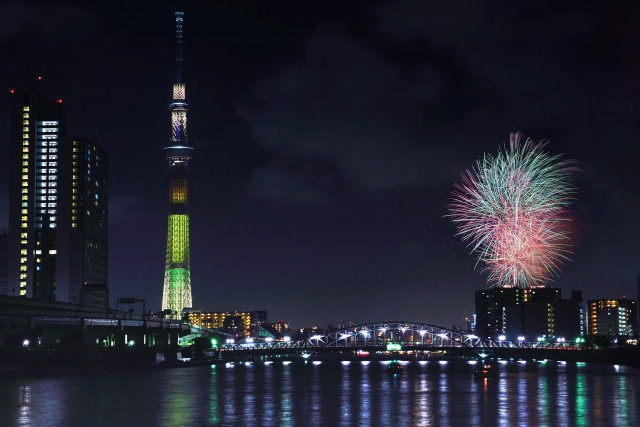
Fireworks festivals are believed to have started in the Edo Period when fireworks were set off around the Sumida River to honor the people who lost their lives due to poverty, disease and starvation. This particular public display of fireworks was not only the start of the Sumidagawa Fireworks Festival, but also launched similar displays around the country to honor people’s deaths as well as ward off evil spirits.
And those traditions have continued to this day.
Many fireworks festivals are held in July and August, as they are often tied with summer - some are even timed to be around the Obon holiday in August which is a period of honoring the deceased - but others are held in other months throughout the year as well.
Writer's Pick
8+ Famous Fireworks Festivals in Japan (and 2023 dates)
Fireworks festivals are held all over the country, many often near rivers, lakes and harbors. While many people may attend and watch the festivals from the ground level, depending on the location, people also watch from their homes, restaurants, tall buildings and rented spaces that have a good view of the fireworks.
Here’s a mix of 8 (and more!) popular and famous fireworks festivals, competitions, and festivals that include fireworks - and when they’ll be held this year!
The first three are what are known as 日本三大花火大会 (Nihon Sandai Hanabi Taikai) - Japan’s Three Great Fireworks Festivals. These are highly regarded by experts as the best in quality.
1. Nagaoka Fireworks Festival (Niigata) ‐ August 2 & 3, 2023
Nagaoka Fireworks Festival (長岡花火大会 Nagaoka Hanabi Taikai) is one of the biggest fireworks festivals in Japan as well as Niigata Prefecture. They are known for their giant fireworks, showcased over two nights at the Shinano River during the first week of August. The nearest station is Nagaoka Station and takes an additional roughly 20 minute walk to the venue. Despite being on weekdays, thousands of people attend.
https://nagaokamatsuri.com/en/
2. Tsuchiura All Japan Fireworks Competition (Ibaraki) - November 4, 2023
Tsuchiura’s fireworks show is considered one of the top 3 fireworks displays in the country, but it’s held towards the end of the year unlike the other two. Despite this, it gets VERY crowded. Take one of the shuttle buses to the Sakura River Embankment which is the main venue, or find a seat along the Sakuragawa River (may require tickets), or find a lesser known free spot.
https://www.tsuchiura-hanabi.jp/
3. Omagari National Fireworks Competition (Akita) - August 26, 2023
The very first Omagari Hanabi Competition was held in 1910, meaning it has over 100 years of history (although it wasn’t held every year), and in 2023, the 95th one will be held in August! The venue is Oomagari no Hanabi Park, and about 40,000 people attend each year. As it’s a competition, you can see the newest and most innovative fireworks!
https://www.oomagari-hanabi.com/
4. Sumidagawa Fireworks Festival (Tokyo) - July 29, 2023
✨テレビ放送中同時開催✨花火ミュージアム企画🎆
— (公式)隅田川花火大会 (@sumida_river_fw) July 25, 2020
現在放送中の【平成24年】のベストショットはこの2枚!!
5月に完成した東京スカイツリーとの初共演。
今では東京スカイツリー自身も花火のように「私たちのまち」を彩る地域のシンボルとなりました。#みんなで隅田川花火大会#東京スカイツリー pic.twitter.com/grEqH9DocT
This is the fireworks festival said to have started them all, and is the most famous fireworks festival in Tokyo. It is normally held on the last Saturday in July in Tokyo. They light more than 20,000 fireworks of all colors and shapes. You can reach Sumidagawa by various stations near the river including Asakusa, Kuramae, (and although a bit of a walk) Tokyo Skytree Station. You could even choose to watch from Skytree or a riverboat if you’re able to get a spot but reservations go fast!
https://www.sumidagawa-hanabi.com/
5. Kamakura Fireworks Festival (Kanagawa) ‐ TBA
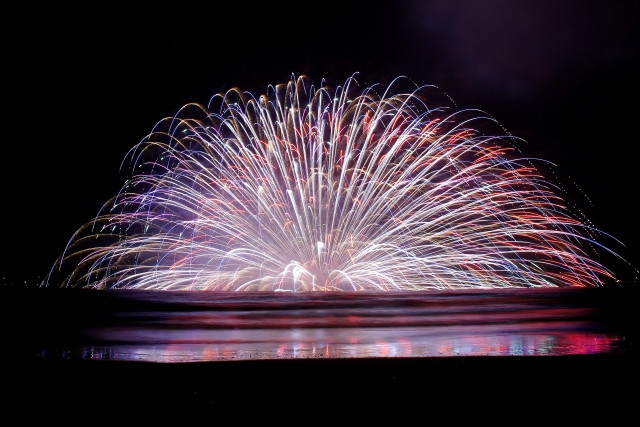
People look forward to Kamakura’s fireworks festival every year because you can enjoy them from many spots along the coastline and the fireworks look especially grand and gorgeous reflected on the ocean at night. They haven’t announced whether they will hold it this year (in 2023) after it having been canceled the last few years because of the pandemic, but we’ll update when there’s definitive information.
Other fireworks festivals in Kanagawa Prefecture include:
- 2023 Kurihama Perry Festival Fireworks (Yokosuka) - July 15, 2023
- Minato Mirai Smart Festival 2023 (Yokohama) - July 31, 2023
- Atsugi Ayu Festival Fireworks (Atsugi) - August 5 & 6, 2023
- Kanazawa Matsuri Fireworks Festival (Yokahama) - August 26, 2023
Biwako Fireworks Festival - August 8, 2023
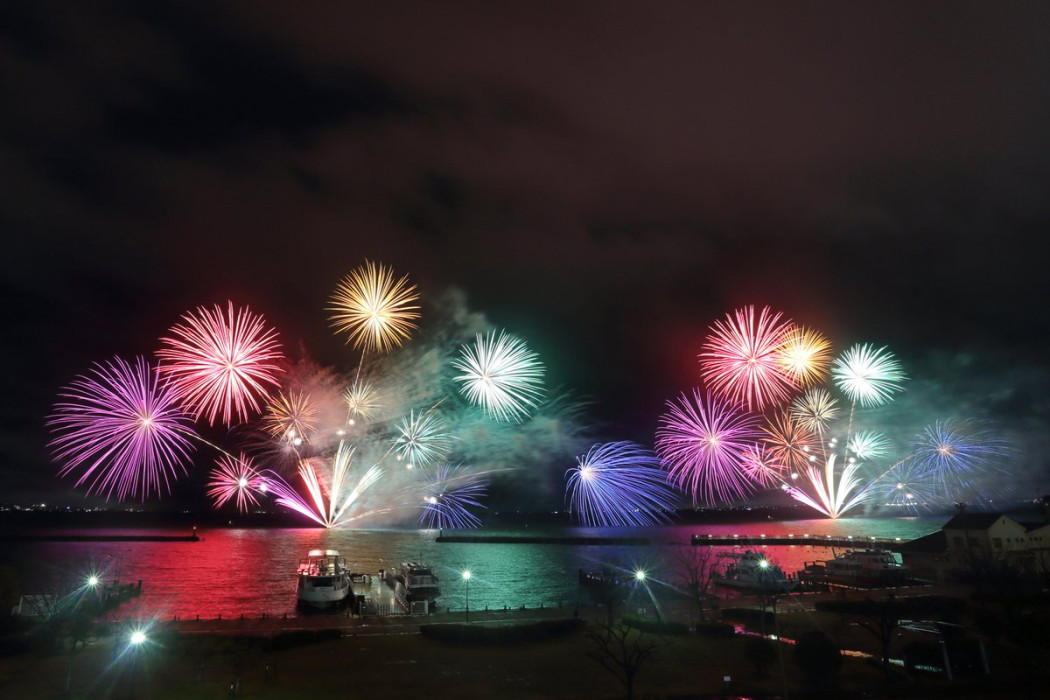
Photo Source
Biwako’s yearly fireworks festival is also returning for the first time in 4 years. The fireworks are launched from the Otsu harbor area of Lake Biwa, the closest stations being JR Otsu Station and Biwako-Hamaotsu Station. There are areas that cost a fee to watch, but there are free areas, such as at the nearby Nagisa Park. It’s only a 10 minute train ride from Kyoto Station, so how about pairing it with your summer Kyoto trip?
https://www.biwako-visitors.jp/hanabi/
7. Osaka Tenjin Matsuri Fireworks - July 25, 2023
大阪の夏の風物詩、天神祭の季節が近づいてきました!約3,000人の行列からなる陸渡御と、約100隻の船が水上を渡御する船渡御。ダイナミックな天神祭のハイライトを、特設の観覧席でご覧いただけるチケットが、絶賛発売中です!
— 大阪観光局【公式】 (@Osaka_Tabilog) May 30, 2019
詳細:https://t.co/L1TFYyVfcU pic.twitter.com/wPyOpvxz7Y
Every year, Osaka’s Tenmangu Shrine holds a huge festival called the Tenjin Matsuri. It’s a 2-day festival and is considered one of the 3 great festivals in Japan. On the second day, portable shrines called mikoshi are carried from the shrine and throughout the areas south and east of the shrine, both through the street and also by river. The finale of the night is the fireworks show on the river.
https://www.tenjinmatsuri.com/
Another big one in Osaka is the Naniwa Yodogawa Fireworks Festival which will be held on August 5, 2023.
8. Kumano Fireworks Festival (Mie) - August 17, 2023
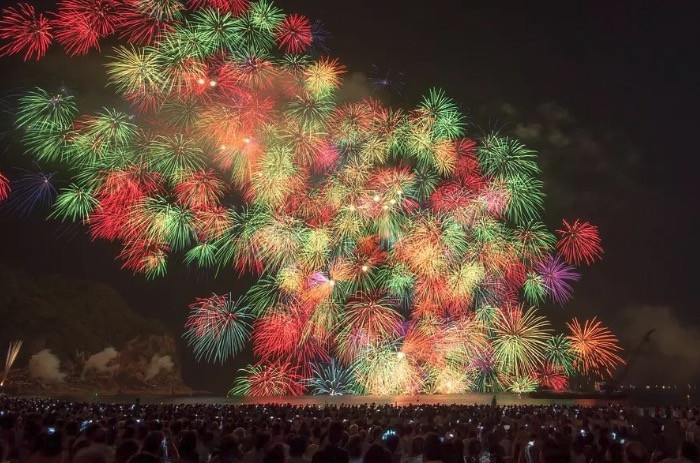
Photo Source
Kumano Fireworks Festival is famous for its fireworks which are launched from boats. It is celebrated on August 17 every year off the coast of Kumano in southern Mie Prefecture. You can get here via Kumanoshi Station and a ten or so minute walk to the beach.
https://www.kumano-kankou.info/kumano-fireworks/
Others to Keep in Mind
Other popular fireworks festivals and competitions in Japan include
- Ise Shrine Fireworks Festival in Mie Prefecture - July 15, 2023
- Ones along Arakawa River bordering Tokyo and Saitama including
- Adachi no Hanabi (July 22)
- Itabashi Fireworks Festival (August 5)
- Koto Fireworks Festival (August 11)
- Kanmon Kaikyo Fireworks Festival (strait between Yamaguchi and Fukuoka Prefectures) - August 13, 2023
- Sanriku Fireworks Competition held in spring and fall in Iwate Prefecture - next one is October 8, 2023
And these fireworks displays that have a longer run than most if you want to see Japanese fireworks somewhere but can’t make it for 1 day events:
- Long-run Hanabi (Inuyama, Aichi) - August 1 ~ 10 (10 min each night)
- Toyako (Hokkaido) - April 28 ~ October 31 (20 min each night)
- Kobe Harbor Fireworks (Hyogo) - October 16 ~ 20, 2023 (10 min each night)
- Tokyo Disneyland and DisneySea - 5 minutes every night
What to Know When Attending a Fireworks Festival in Japan
So you’ve decided to go to a hanabi festival in Japan! Here are some things to keep in mind.
Cost
First, if you want to have the very best seats close to the action (and not having to worry about going quite early to save your spot the day of), you will most likely have to pay for them. These have to be reserved in advance (sometimes months beforehand) so make sure to look them up beforehand for the festival you wish to attend. Sometimes the tickets are so popular for these seats that they are sold by lottery system.
But it’s free to watch from areas outside of the paid seating areas. There are the popular free viewing spots, but there’s always the lesser known 穴場 (anaba) spots that only “few” people know that have great views. Some people will arrive way in advance on the day to reserve the best free viewing areas.
What to Bring
While nothing is mandatory, you may enjoy it better if you bring
- a seating mat or picnic blanket if you will be sitting on the ground (which can also be used to reserve your spot!)
- food and snacks (you can also often buy food at the stalls and stands around the venue but expect it to be crowded)
- water bottles (and alcohol if you wish)
- card games and such to pass the time
- money to pay for food and games (it depends on the venue, but some may only take cash)
- sunscreen and bug repellent
- etc.
And definitely wear breezy and comfortable clothes (How about trying out a yukata?) and bring a hat, handheld fans and towels as it will probably be hot during the day while you wait for the fireworks show to start.
Length of Fireworks Show
It usually lasts between one to two hours depending on the show, but it varies from location to location. There is often an intermission between the first half and second half, especially for the larger more famous shows. They usually start around 7 pm or when it gets dark out.
Other Things to Do
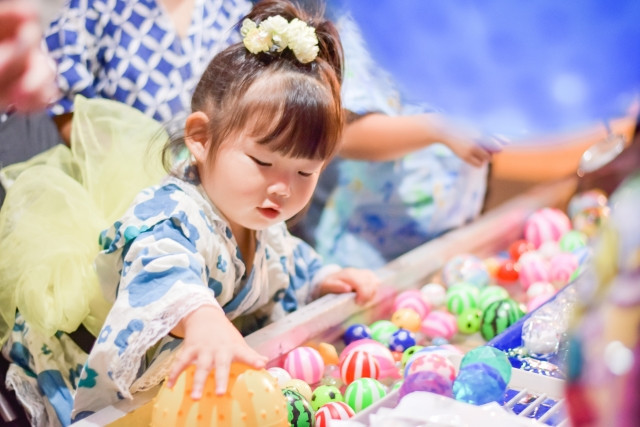
Like mentioned above, various food and game stalls are often set up near where people gather to see the fireworks. Japanese people eat typical festival food and play festival games at the stalls before heading for a good spot to watch the fireworks.
Arriving and Going Back
The stations around the venue and trains and other transportation leading there will be very crowded, especially as time gets closer to the actual fireworks show. Also, as the crowds will be huge, it will be very difficult to meet up with people unless you have a designated meeting spot. Once you are in the middle of a field with thousands of others, especially after it gets dark, it will be too difficult to locate each other (so make sure to use the restroom while it’s still light out!).
Speaking of restrooms, there will probably only be a few public restrooms in the area (there may be some portable ones set up), so locate them as soon as you can so you know where they are, especially if you will be at the venue for a while.
After the fireworks show, the event organizers may conduct staggered exits by area in order to prevent overcrowding at the station and bus stops. Please wait until your section is called to leave in that case.
We advise walking to a further station or waiting out the rush somewhere nearby to avoid the worst crowds all trying to go home at the same time.
Conclusion
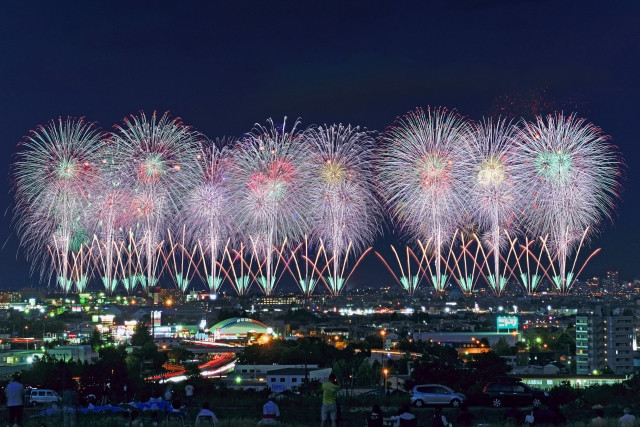
If you are a visitor or resident in Japan in the months of summer then you must keep fireworks on your list. They are regarded as a perfect place to be enjoyed with friends in the summer. Again, we only mentioned a few so make sure to check out the best ones in your area...or try to see as many as you can in one summer!














.jpg)







 (2).png)













